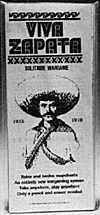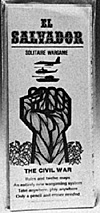
Robert Mansfield Company 224
Woodlawn Terrace, Collingswood, NJ 08108
Price: $2.00
Complexity: Intermediate
Solitaire Suitability: Excellent
Viva Zapata is a solitaire game of the guerilla insurrection in Mexico from 1912 to 1915. One player takes the part of the Zapatista guerillas; his opponent, the Army, is controlled by random reactions. The objective of the Zapatista player is to control Mexico City. The game is of indeterminate length and is either decided when Mexico City is captured (Zapatistas win) or when the Zapatista player runs out of supplies.
El Salvador is a solitaire game of the guerilla insurrection in El Salvador going on now using the same game system. The player takes the part of the guerilla forces, with his opponent (the Army) being controlled by random reactions. The objective of the guerilla player is to control San Salvador.
I found the solitaire system for these games easy to use and reasonably challenging to beat; however, once I learned how to anticipate the Army's moves, play generally became predictable. Still, I think that it is diverting and worth the very reasonable $2.00 price tag.
The mapsheet is the only component that is actually used in play. No counters or game markers are used, just a pencil. In Viva Zapata the mapsheet consists of the area of Mexico around and to the south of Mexico City; while El Salvador's mapsheet consists of the El Salvador and parts of Honduras and Guatemala. The mapsheet is divided into many places. Each place is divided into two or more sections. The moves of the Zapatistas and the Army are indicated by coloring in the sections of places on the map with a pencil. A place can either be open, guerilla occupied, Army controlled, contested, or Zapatista depending on which sections of the place are colored in.
 As the player and Army execute their
moves, the places in question change status and
different sections are erased or colored. it is
essential that the player recognize the distinction
between the different place statuses. Places are
connected to each other by either solid or dotted
lines which regulate possible moves and supply.
Places are adjacent if it is possible to trace a solid
or dotted line from one to the other without
encountering another place. Places are accessible
to the Army if it is possible to trace a solid line
from the place to a town or city without
encountering guerilla forces. Most places are also
grouped into areas, which regulate the Army's
moves.
As the player and Army execute their
moves, the places in question change status and
different sections are erased or colored. it is
essential that the player recognize the distinction
between the different place statuses. Places are
connected to each other by either solid or dotted
lines which regulate possible moves and supply.
Places are adjacent if it is possible to trace a solid
or dotted line from one to the other without
encountering another place. Places are accessible
to the Army if it is possible to trace a solid line
from the place to a town or city without
encountering guerilla forces. Most places are also
grouped into areas, which regulate the Army's
moves.
The game is played in turns, and the first step in each turn is for the player to determine how many moves can be made by the Zapatistas guerillas. Until the actual assault on Mexico City or San Salvador is made, the primary objective of the player is to increase the available supply points. After determining the number of moves, the player colors in the left half places which are adjacent to Zapatista places, indicating a player's attempt to control a place.
The Army then gets to react. This is done by randomly marking one square in the circle grid. The square marked will be at the intersection of two letters which are then used on the Government Response Box (GRB) to find out what the Army does. Each part of the GRB contains an area name and a response letter. The Army moves are divided into two parts. First the Army moves into the area specified by the GRB. Then the small letter is used to determine the Army's move into every area where the Zapatista has made a move.
The areas are resolved one at a time in the order that the player chooses, and each area is completely resolved before the next is started. The results of Army moves are indicated on the Movement Results Table (MRT), which shows the resulting status and the supply point changes depending on the initial status of each type of place. After the Army has completed its reaction in an area, any remaining guerilla occupied or controlled places are resolved on another section of the MRT. The supply points for the next turn are then adjusted.
To determine the best strategy for the guerillas, the player must examine and understand the MRT. The only time that the guerilla player gains supply is when the area that is taken is inaccessible. This dictates the initial guerilla strategy which is to occupy the higher numbered places in an area in an effort to surround the Army places. After they are inaccessible, they can be taken with a net gain of supply. The guerilla player may eventually have enough supply to directly attack areas and risk the loss of supply to gain territory.
A solitaire game's success is deLcrmined by the skill and ease with which the opponent makes its moves. Despite the fact that no dice are used, the two step circle grid and Government Response Table process adds enough randomness so that the Army's moves are not known unless the player makes a conscious effort to cheat. in this game, it is not difficult to resolve the moves, but it is extremely important to note the semantic distinctions between the different occupation statuses. If you don't, it is easy to make the Army go to the wrong place. it took several playings before I was confident with what I was doing. This is the reason that I call this game basically simple intermediate.
My general response to this game is neutral. I found play somewhat dry and felt that I was more concerned with coloring in places than advancing on Mexico City or San Salvador. Once I learned the effective guerilla strategy, play became repetitive. Still, it was a challenge to win with the Zapatistas. Viva Zapata and El Salvador are worth a look if you like solitaire games, especially at the price. How can you go wrong for $2.00?
More Reviews
-
Game Review: Battlewagon WWI and WWII Naval
Game Review: Battlestar Galactica
Game Review: Viva Zapata, El Salvador
Game Review: Europa: Spain and Portugal (SCW)
Game Review: Kampfgruppe (WWII Computer Game)
Game Review: Purple Heart (WWII Ambush Module)
Game Review: Knights of the Desert (WWII Computer Game)
Game Review: Space Race (NASA)
Game Review: Cutthroats (Computer Game)
Game Review: Wildcatter (Oil Drilling Game)
Game Review: Worlds of Boris Vallejo
Game Review: Golden Heroes (Superhero RPG)
Game Review: Signal GK (Traveller sci-fi)
Game Review: Margin of Profit (Star Trek)
Game Review: Ascent to Anekthor (Traveller sci-fi)
Back to Table of Contents -- Game News #5
To Game News List of Issues
To MagWeb Master Magazine List
© Copyright 2000 by Dana Lombardy.
This article appears in MagWeb (Magazine Web) on the Internet World Wide Web.
Other military history articles and gaming articles are available at http://www.magweb.com